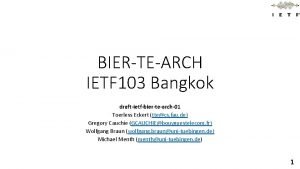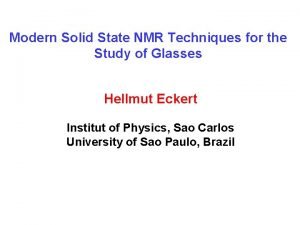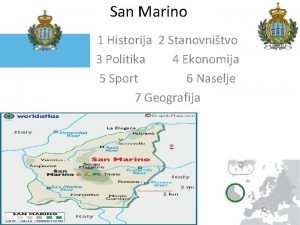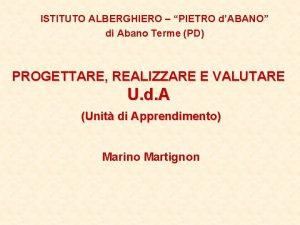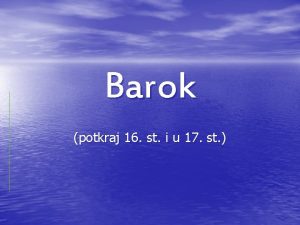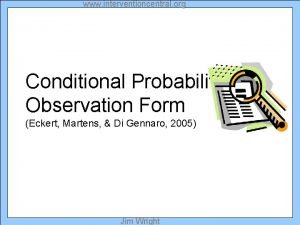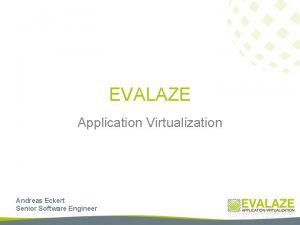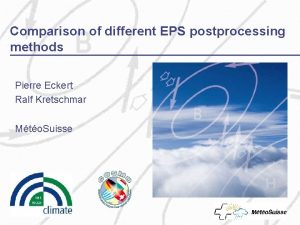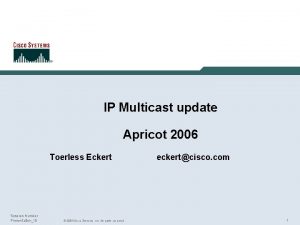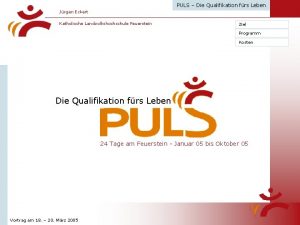IA 32 Architecture Richard Eckert Anthony Marino Matt


































- Slides: 34

IA- 32 Architecture Richard Eckert Anthony Marino Matt Morrison Steve Sonntag

IA-32 Overview • IA-32 Overview – – • Hyper Pipeline – – • Levels of Cache (L 1 & L 2) / Execution Trace Cache Instruction Decoder System Bus Register Files – • Address Translation Cache – – – • Segmentation Paging Virtual Memory Address Modes / Instruction Format – • Rapid Execution Engine Advanced Dynamic Execution Memory Management – – – • Overview Branch Prediction Execution Types – – • Pentium 4 / Netburst µArchitecture SSE 2 Enhanced Floating Point & Multi-Media Unit Summary / Conclusion

IA-32 Background • Traced to 1969 – Intel 4004 • P 4 – 1 st IA-32 processor based on Intel Netburst microprocessor. • Netburst – Allows • Higher Performance Levels • Performance at Higher Clock Speeds • Compatible with existing applications and operating systems – Written to run on Intel IA-32 architecture Processors

1 st Implementation of Intel Netburst µArchitecture • Rapid Execution Engine • Hyper Pipelined Technology • Advanced Dynamic Execution • Innovative Cache Subsystem • Streaming SIMD Extensions 2 (SSE 2) • 400 MHz System Bus

Netburst µArchitecture

SSE 2 • Internet Streaming SIMD Extensions 2 (SSE 2) – What is it? – What does it do? – How is this helpful?

IA-32 Overview • IA-32 Overview – – • Hyper Pipeline – – • Levels of Cache (L 1 & L 2) / Execution Trace Cache Instruction Decoder System Bus Register Files – • Address Translation Cache – – – • Segmentation Paging Virtual Memory Address Modes / Instruction Format – • Rapid Execution Engine Advanced Dynamic Execution Memory Management – – – • Overview Branch Prediction Execution Types – – • Pentium 4 / Netburst µArchitecture SSE 2 Enhanced Floating Point & Multi-Media Unit Summary / Conclusion

Hyper Pipelined • What is hyper pipeline technology? – Deeper pipeline – Fewer gates per pipeline stage • What are the benefits of hyper pipeline? – Increased clock rate – Increased performance

Netburst vs. P 6 ™ 1 2 3 4 5 6 7 8 9 10 Fetch Decode Rename ROB Rd Rdy/Sch Dispatch Exec Typical P 6 Pipeline 1 2 3 4 5 6 7 8 9 10 11 12 13 14 15 16 17 18 19 20 TC Nxt IP TC Fetch. Drive. Alloc Rename Que Sch Sch Disp RF RF Ex Flgs Br. Ck Drive Typical Pentium 4 Pipeline

1 2 3 4 5 6 7 8 9 10 11 12 13 14 15 16 17 18 19 20 TC Nxt IP TC Fetch. Drive. Alloc Rename Que Sch Sch Disp RF RF Ex Flgs Br. Ck Drive BTB Store AGU Load AGU ALU ALU FP RF FP move FP store Fmul Fadd MMX SSE L 1 D-Cache and D-TLB Integer RF Schedulers op Queues Code ROM Rename/Alloc Trace Cache Decoder BTB & I-TLB 3. 2 GB/s System Interface L 2 Cache and Control

Netburst µArchitecture

Branch Prediction • Centerpiece of dynamic execution – Delivers high performance in pipelined - architecture • Allows continuous fetching and execution – Predicts next instruction address • Branch is predictable within 4 or less iterations Branch Prediction decreases the amount of instructions that would normally be flushed from pipeline

Examples If (a == 5) a = 7; Else a = 5; Predictable L 1: lpcnt++; If ((lpcnt % 5)== 0) printf (“ Loop count is divisible by 5n”); Not Predictable

IA-32 Overview • IA-32 Overview – – • Hyper Pipeline – – • Levels of Cache (L 1 & L 2) / Execution Trace Cache Instruction Decoder System Bus Register Files – • Address Translation Cache – – – • Segmentation Paging Virtual Memory Address Modes / Instruction Format – • Rapid Execution Engine Advanced Dynamic Execution Memory Management – – – • Overview Branch Prediction Execution Types – – • Pentium 4 / Netburst µArchitecture SSE 2 Enhanced Floating Point & Multi-Media Unit Summary / Conclusion

Rapid Execution Engine • Contains 2 ALU’s – Twice core processor frequency • Allows basic integer instructions to execute in ½ a clock cycle • Up to 126 instructions, 48 load, and 24 stores can be in flight at the same time • Example – Rapid Execution Engine on a 1. 50 GHz P 4 Processor runs at _____Hz?

Out-of-Order Execution Logic Retirement Logic ` Branch History Update

Advanced Dynamic Execution • Out-of-Order Engine – Reorders Instructions – Executes as input operands are ready – ALU’s kept busy • Reports Branch History Information • Increases overall speed

IA-32 Overview • IA-32 Overview – – • Hyper Pipeline – – • Levels of Cache (L 1 & L 2) / Execution Trace Cache Instruction Decoder System Bus Register Files – • Address Translation Cache – – – • Paging Virtual Memory Segmentation Address Modes / Instruction Format – • Rapid Execution Engine Advanced Dynamic Execution Memory Management – – – • Overview Branch Prediction Execution Types – – • Pentium 4 / Netburst µArchitecture SSE 2 Enhanced Floating Point & Multi-Media Unit Summary / Conclusion

Memory Management • Management Facilities divided into two parts: Segmentation - isolates individual processes so that multiple programs can on same processor without interfering w/each other. Demand Paging - provides a mechanism for implementing a virtual-memory that is much larger than the actual memory, seemingly infinite.

Memory Management Ex: Comp. Arch. I Address Translation Instruction Address IA-32 Instruction Decoder Control Word Memory Control Word (Virtual Address) Logical Address Segmentation & Paging Physical Address Memory

Concentration on: Modes of Operation • Protected mode - Native operating mode of the processor. All features available, providing highest performance and capability. - Must use segmentation, paging optional. Other modes: • Real-address mode - 8086 processor programming environment • System management mode (SMM) - Standard arch. feature in all later IA-32 processors. Power management, OEM differentiation features • Virtual-8086 mode - used while in protected mode, allows processor to execute 8086 software in a protected, multitasked environment.

Paging • Subdivide memory into small fixed-size “chunks” called frames or page frames • Divide programs into same sized chunks, called pages • Loading a program in memory requires the allocation of the required number of pages • Limits wasted memory to a fraction of the last page • Page frames used in loading process need not be contiguous - Each program has a page table associated with it that maps each program page to a memory page frame

IA-32: 2 - Level Paging Linear Address Logical Address Segmentation Dir Page Offset Physical Address Control Word Virtual Memory: • Only program pages required for execution of the program are actually loaded “Demand” Paging • Only a few pages of any one program might be in memory at a time • Possible to run program consisting of more pages than can fit in memory Page Directory Paging Page Table Main Memory

Segmentation • Programmer subdivides the program into logical units called segments - Programs subdivided by function - Data array items grouped together as a unit • Paging - invisible to programmer, Segmentation - usually visible to programmer - Convenience for organizing programs and data, and a means for associating access and usage rights with instructions and data - Sharing, segment could be addressed by other processes, ex: table of data - Dynamic size, growing data structure

Address Translation Segment Offset Linear Address Dir Page Offset Physical Address Control Word Segment Table Index TI RPL Index: The number of the segment. Serves as an index to the segment Table. TI: (one bit) Table indicator indicates either global or local segment table to be used for translation RPL: (two bits) Requested privilege level, 0=high privilege, 3 = low Page Directory Paging Page Table Main Memory

IA-32 Overview • IA-32 Overview – – • Hyper Pipeline – – • Levels of Cache (L 1 & L 2) / Execution Trace Cache Instruction Decoder System Bus Register Files – • Address Translation Cache – – – • Paging Virtual Memory Segmentation Address Modes / Instruction Format – • Rapid Execution Engine Advanced Dynamic Execution Memory Management – – – • Overview Branch Prediction Execution Types – – • Pentium 4 / Netburst µArchitecture SSE 2 Enhanced Floating Point & Multi-Media Unit Summary / Conclusion

Offset - Determine technique for offset generation Base Register Index Register x Scale 1, 2, 4, or 8 + Descriptor Registers Access Rights Limit Base Address Effective Address (Offset) Segment Base Address Displacement (in instruction; 0, 8, or 32 bits) + Linear Address Limit Segment Addressing Modes Paging (invisible to programmer) Main Memory

Addressing Modes

Ex: scaled index with displacement Segment Index Register x Scale 1, 2, 4, or 8 Descriptor Registers Access Rights Limit Base Address Effective Address (Offset) Segment Base Address Displacement (in instruction; 0, 8, or 32 bits) + Linear Address Limit +

Instruction Format Bytes 0 or 1 Instruction Segment Prefix Override Bytes 0 or 1 Operand Address Size Override 0 to 4 1 or 2 0 or 1 0, 1, 2, or 4 Instruction Prefixes Opcode Mod R/M SIB Displacement Mod 7 Reg/Opcode 6 5 4 3 2 R/M 1 Scale 0 7 6 5 Index 4 0, 1, 2, or 4 Immediate Base 3 2 1 0

IA-32 Overview • IA-32 Overview – – • Hyper Pipeline – – • Levels of Cache (L 1 & L 2) / Execution Trace Cache Instruction Decoder System Bus Register Files – • Address Translation Cache – – – • Segmentation Paging Virtual Memory Address Modes / Instruction Format – • Rapid Execution Engine Advanced Dynamic Execution Memory Management – – – • Overview Branch Prediction Execution Types – – • Pentium 4 / Netburst µArchitecture SSE 2 Enhanced Floating Point & Multi-Media Unit Summary / Conclusion

Cache Organization Physical Memory System Bus (External) L 2 Cache Data Cache Unit (L 1) Instruction TLBs Bus Interface Unit Data TLBs Instruction Decoder Trace Cache Store Buffer

IA-32 Overview • IA-32 Overview – – • Hyper Pipeline – – • Levels of Cache (L 1 & L 2) / Execution Trace Cache Instruction Decoder System Bus Register Files – • Address Translation Cache – – – • Segmentation Paging Virtual Memory Address Modes / Instruction Format – • Rapid Execution Engine Advanced Dynamic Execution Memory Management – – – • Overview Branch Prediction Execution Types – – • Pentium 4 / Netburst µArchitecture SSE 2 Enhanced Floating Point & Multi-Media Unit Summary / Conclusion

Enhanced FP & Multi-Media Unit • Expands Registers – 128 -bit – Adds One Additional Register • Data Movement • Improves performance on applications – Floating Point – Multi-Media
 Prof. dr. marcus eckert
Prof. dr. marcus eckert Toerless eckert
Toerless eckert Toerless eckert
Toerless eckert Eckert bálint
Eckert bálint Eckert bálint
Eckert bálint Hellmut eckert
Hellmut eckert King richard iii and looking for richard
King richard iii and looking for richard Ecosistemas costeros de la república dominicana
Ecosistemas costeros de la república dominicana San marino broj stanovnika
San marino broj stanovnika Ljudski život marino
Ljudski život marino Conocimiento del medio segundo grado
Conocimiento del medio segundo grado Paul l marino
Paul l marino Poesia arturo prat chacon para niños
Poesia arturo prat chacon para niños Paul l marino
Paul l marino Definición de estrecho marino
Definición de estrecho marino Marino nonis
Marino nonis Dan marino number
Dan marino number Bella schiava figure retoriche
Bella schiava figure retoriche Karakia mo te kai
Karakia mo te kai Barco de simbad el marino
Barco de simbad el marino Ecosistema marino scuola primaria
Ecosistema marino scuola primaria Grosso uccelli marino
Grosso uccelli marino Jose jesus y sofia tienen una cometa cada uno
Jose jesus y sofia tienen una cometa cada uno Eleonora marino
Eleonora marino Plactónicos
Plactónicos Factores bióticos y abióticos de un ecosistema acuático
Factores bióticos y abióticos de un ecosistema acuático Istituto alberghiero pietro d'abano
Istituto alberghiero pietro d'abano Grafico inquinamento marino
Grafico inquinamento marino Glen marino
Glen marino Jasper marino
Jasper marino Pjevač giambattista marino
Pjevač giambattista marino Antigone marino
Antigone marino Architecture business life cycle
Architecture business life cycle Call and return architecture in software engineering
Call and return architecture in software engineering Integral architecture example
Integral architecture example


